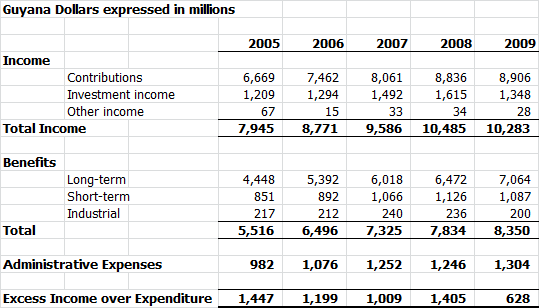In making his case for an increased financial contribution to the state-owned Guyana Sugar Corporation President Jagdeo is quoted as saying that “government’s commitment to sugar has nothing to do with the workers being ‘a party support base,’ but rather with the development of the sector which contributes some 16 per cent of the country’s Gross Domestic Product.” One is never sure whether the President’s loose use of facts and data is politically driven or is evidence of his unfamiliarity with up-to-date national income statistics. In normal circumstances, he can be dismissed but not when, as in the case of the building of the packaging plant, what he mistakenly thinks forms the basis of major spending decisions.
This is what the most recent official figures published by the government show in relation to sugar’s contribution to the economy measured by GDP:
It is perhaps not without some significance but with considerable irony that GuySuCo Director Keith Burrowes used the occasion to announce his assessment of Mr Jagdeo as Guyana’s best president ever, which obviously includes Cheddi Jagan who waged a life-long struggle for sugar workers. Mr Jagdeo of course, led GuySuCo into the inadequately conceived and poorly executed US$200 million Skeldon modernization project which drove the corporation to the brink of insolvency from which its survival requires a combination of:
1. sales of a depleting quantity of sugar lands. Before a substantial sale of lands at Diamond in 2009, only 28% of the lands used to derive economic benefits to the corporation were actually owned by it;
2. the indefinite continuation of subsidised peppercorn rent of G$1,000 per acre per year;
3. the assumption/payment by the government of the corporation’s debts; and
4. various other forms of subsidy including the deferral of taxes of $2.3 billion over a five-year period without penalties.
Director Donald Ramotar has sought to distance himself and fellow directors including Mr Burrowes and Ms Gita Singh-Knight from responsibility for the plight of the corporation. This is not only legally flawed, it is also totally unfair. The political and corporate directorate has practically imposed on the management not only an unbearable debt burden, but some $1,900 million of capitalised interest at December 2009. This is a huge non-productive cost to bear and the executive management deserves the nation’s sympathy.
The problem for the corporation and for the country as a whole which Mr David Granger’s “privatization” comment did not reflect is that in its present form and with its existing liabilities it would be impossible to find a buyer for GuySuCo. A buyer would almost certainly insist on an asset purchase in which the cost of the Skeldon factory would have to be heavily discounted. That would leave the country to meet the lion’s share of tens of billions of liabilities at December 31, 2009, the last year for which the corporation’s financial statements are available.
While Mr Jagdeo will soon be enjoying a gigantic retirement package which he signed into law and under which he pays no taxes, the debts he continues to amass for the corporation and the country will have to be paid by the workers in sugar and other sectors and the taxpayers and consumers of this country. Mr Burrowes may have cause to rejoice and exult, but not those groups.
The packaging plant will certainly add value but will not be a magic bullet to salvage Jagdeo’s and the board’s stand-out sugar decision. Packaging plants are the wave of the sugar industry as several countries in Africa, Australia and here in South America expand into sugar packaging in a bid to remain competitive. Kenya’s largest sugar miller, Mumias Sugar Company (MSC) recently built, at a cost of US$3 million, a new eleven-machine, state-of-the-art packaging plant with a daily capacity of 700t, enabling the company’s packaging production capacity to increase to 300,000t per annum. Incidentally, the packaging machines for MSC were supplied by Brazilian companies Brazafric and Raumak while we trekked to India to source our plant!
With the continuing trend towards more and sophisticated packaging by the industry internationally, GuySuCo’s only hope of survival without further and more costly and unaffordable state support is to drastically cut its cost of production in line with the rest of the world. That imperative was conveniently ignored at the launch of the packaging plant.


